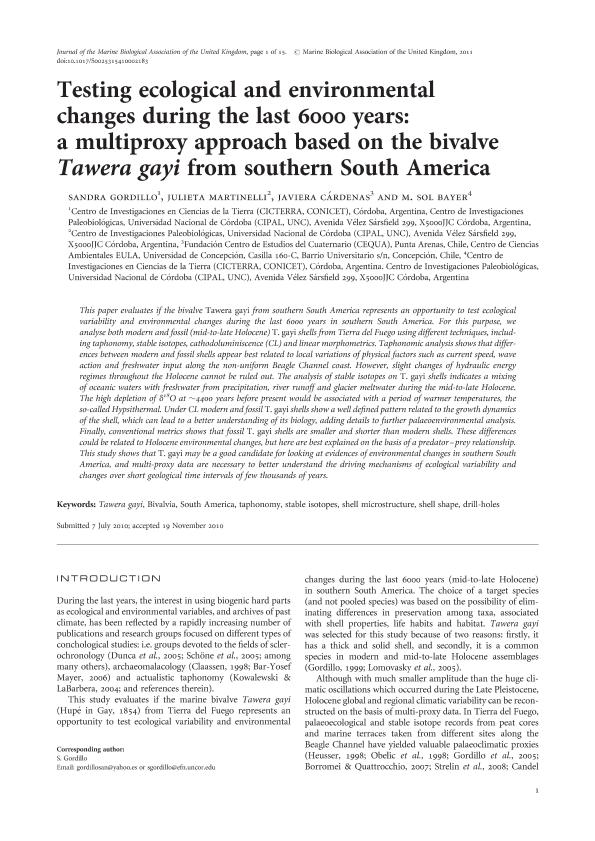Artículo
Testing ecological and environmental changes during the last 6000 years: A multiproxy approach based on the bivalve Tawera gayi from southern South America
Fecha de publicación:
11/2011
Editorial:
Cambridge University Press
Revista:
Journal of the Marine Biological Association of the United Kingdom
ISSN:
0025-3154
Idioma:
Inglés
Tipo de recurso:
Artículo publicado
Clasificación temática:
Resumen
This paper evaluates if the bivalve Tawera gayi from southern South America represents an opportunity to test ecological variability and environmental changes during the last 6000 years in southern South America. For this purpose, we analyse both modern and fossil (mid-to-late Holocene) T. gayi shells from Tierra del Fuego using different techniques, including taphonomy, stable isotopes, cathodoluminiscence (CL) and linear morphometrics. Taphonomic analysis shows that differences between modern and fossil shells appear best related to local variations of physical factors such as current speed, wave action and freshwater input along the non-uniform Beagle Channel coast. However, slight changes of hydraulic energy regimes throughout the Holocene cannot be ruled out. The analysis of stable isotopes on T. gayi shells indicates a mixing of oceanic waters with freshwater from precipitation, river runoff and glacier meltwater during the mid-to-late Holocene. The high depletion of δ18O at ~4400 years before present would be associated with a period of warmer temperatures, the so-called Hypsithermal. Under CL modern and fossil T. gayi shells show a well defined pattern related to the growth dynamics of the shell, which can lead to a better understanding of its biology, adding details to further palaeoenvironmental analysis. Finally, conventional metrics shows that fossil T. gayi shells are smaller and shorter than modern shells. These differences could be related to Holocene environmental changes, but here are best explained on the basis of a predator–prey relationship. This study shows that T. gayi may be a good candidate for looking at evidences of environmental changes in southern South America, and multi-proxy data are necessary to better understand the driving mechanisms of ecological variability and changes over short geological time intervals of few thousands of years.
Palabras clave:
TAWERA GAYI
,
BIVALVIA
,
SOUTH AMERICA
,
TAPHONOMY
Archivos asociados
Licencia
Identificadores
Colecciones
Articulos(CICTERRA)
Articulos de CENTRO DE INVEST.EN CS.DE LA TIERRA
Articulos de CENTRO DE INVEST.EN CS.DE LA TIERRA
Citación
Gordillo, Sandra; Odisio Martinelli, Julieta; Cardenas, Javiera; Bayer, María Sol; Testing ecological and environmental changes during the last 6000 years: A multiproxy approach based on the bivalve Tawera gayi from southern South America; Cambridge University Press; Journal of the Marine Biological Association of the United Kingdom; 91; 7; 11-2011; 1413-1427
Compartir
Altmétricas




